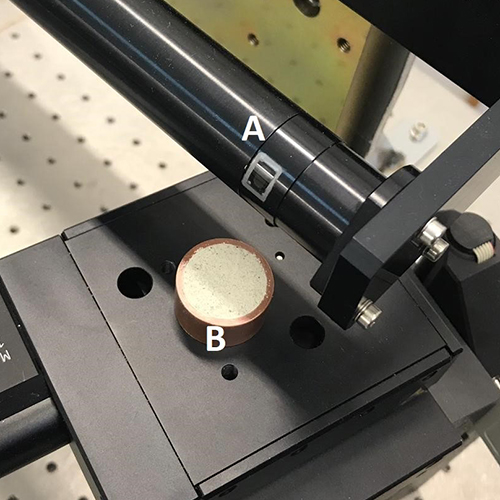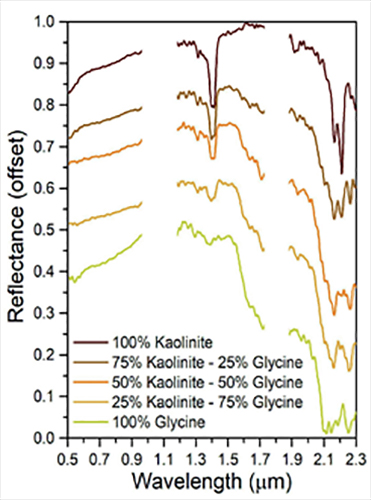Testing the Ma_MISS instrument capabilities for organics detection
- 1INAF-IAPS, Rome, Italy (marco.ferrari@inaf.it)
- 2ASI, Rome, Italy
Abstract
Laboratory measurements were performed on different mixtures made with clays and organic compounds with the aim of characterizing the detection capabilities of biosignatures by the Ma_MISS (Mars Multispectral Imager for Subsurface Studies) instrument.
Introduction
The main scientific objectives of the ESA mission ExoMars2022 are searching for signs of past and/or present life on Mars and characterizing the subsurface geochemical environment as a function of depth. The Rosalind Franklyn rover [1] payload consists of a suite of nine instruments that will provide information about the geological and geochemical environment of the surface and subsurface of the selected landing site (i.e. Oxia Planum) [2]. Remote sensing measurements performed by OMEGA and CRISM suggest that the exposed rocks on the surface of Oxia Planum experienced an intense aqueous alteration [3]. The widespread presence of Fe/Mg-Al-phyllosilicates and, more generally, the presence of silicates containing OH confirm the interaction between water and mother rocks, which is a prerequisite favorable to the development of life. In this framework, we performed several spectroscopic measurements of clay minerals mixed with different organic compounds, to assess Ma_MISS capability of organic’s detection in the Martian subsurface.
The Ma_MISS instrument
Ma_MISS is the Visible- and Near-Infrared miniaturized spectrometer hosted in the drill system of the ExoMars2022 rover that will characterize the mineralogy and stratigraphy of the excavated borehole wall at different depths (<2 m) [4]. Ma_MISS with a spectral range of 0.5–2.3 μm, a spectral resolution of about 20 nm in the IR, a SNR~100, and a spatial resolution of 120 μm will accomplish the following scientific objectives: (1) determine the composition of the subsurface materials; (2) map the distribution of the subsurface H2O and hydrated phases; (3) characterize important optical and physical properties of the materials (e.g., grain size); (4) produce a stratigraphic column that will provide information on the subsurface geology. Ma_MISS will operate periodically during pauses in drilling activity and will produce hyperspectral images of the drill’s borehole.
Experimental setup
The characterization of the scientific performances of the Ma_MISS instrument was made using the laboratory model (breadboard, Fig. 1 [5], [6]) at the Institute for Space Astrophysics and Planetology – INAF. The Ma_MISS breadboard includes the 5 W light source, the optical fibers, and the Optical Head with the dual task of focusing the light on the target and recollecting the scattered light. However, it does not include the flight spectrometer and is therefore coupled with a laboratory spectrometer (FieldSpec 4).

Fig. 1: Ma_MISS breadboard setup. A: Ma_MISS Optical Head; B: sample holder.
Clay/organic mixtures measurements
For these tests we prepared numerous samples mixing two clay minerals (nontronite and kaolinite) with four different organic compounds (asphaltite, glycine, benzoic acid, and polyoxymethylene). In particular, starting from the pure clay endmembers we tested two cases. In the first case, we added separately asphaltite and glycine in the following percentages: 25, 50, and 75, producing six different samples with high organics concentration. In the second case, we added separately benzoic acid and polyoxymethylene in percentages of 1, 5, and 10% preparing a set of six samples at a low concentration of organics. All mixtures with a grain size < 60 μm were measured using the Ma_MISS breadboard setup collecting reflectance spectra in the range 0.5–2.3 μm. Figure 2 shows an example of the data collected on the mixtures between kaolinite and glycine. Starting from the spectra of the pure clay (kaolinite 100%, black spectrum in Fig.2) and increasing the content of glycine by step of 25 wt.%, the band at 1.4 μm associated to the presence of the OH bond in kaolinite decreases. At the same time the band at 2.1–2.2 μm linked to the Al–OH bond in kaolinite become wider and much stronger due to the superimposition of the wider CH band of glycine at 2.1–2.25 μm.
Other mixtures with other types of organics in a concentration below the 1% are still in preparation with the aim of determining the lower detection limit of the instrument in the function of the different hosting minerals. In these tests, we used glycine and other organic compounds, as examples of organic compounds that show absorption features in the VIS-NIR range, although we do not expect to find these specific organics in the Martian subsurface.

Fig. 2: Example of Ma_MISS breadboard measurements of mineral/organic mixtures (kaolinite-glycine) in variable proportion.
Conclusions
Laboratory investigations have been performed using the Ma_MISS breadboard model (coupled with a FieldSpec Pro) on mineral/organic mixtures in different proportions. Spectroscopic measurements collected on these mineral/organic mixtures are useful to characterize Ma_MISS instrument sensitivity in detecting traces of life intimately mixed with minerals that could be present in sedimentary sequences or in hydrothermal products in the Martian subsurface, which is one of the main scientific objectives of the ExoMars2022 mission. The obtained results show that the Ma_MISS instrument can give hints of the presence of organics in the Martian subsoil, as well as characterizing the mineralogy of the drilling site. Moreover, the selected minerals and organic compounds allow us to test the instrument with both dark and bright samples. The spectra obtained during these tests will allow us to build a spectral database useful for the interpretation of the scientific data.
Acknowledgments
We thank the European Space Agency (ESA) for the ExoMars Project, ROSCOSMOS and Thales Alenia Space for rover development, and Italian Space Agency (ASI) for funding and fully supporting Ma_MISS experiment.
References
[1] Vago J.L. et al. (2017): Astrobiology, 17, 6, 7. [2] Quantin C. et al (2016) #2863, 47th LPSC, Houston, TX. [3] Carter J. et al. al (2016) #2064, 47th LPSC, Houston, TX. [4] De Sanctis M.C. et al. (2017): Astrobiology, 17, 6, 7. [5] De Angelis S. et al. (2014): PSS, 101, 89-107. [6] De Angelis S. et al. (2017): PSS, 144, 1-15.
How to cite: Ferrari, M., De Angelis, S., De Sanctis, M. C., Altieri, F., Ammannito, E., Frigeri, A., Formisano, M., Mugnuolo, R., and Pirrotta, S.: Testing the Ma_MISS instrument capabilities for organics detection, Europlanet Science Congress 2020, online, 21 September–9 Oct 2020, EPSC2020-348, https://doi.org/10.5194/epsc2020-348, 2020

